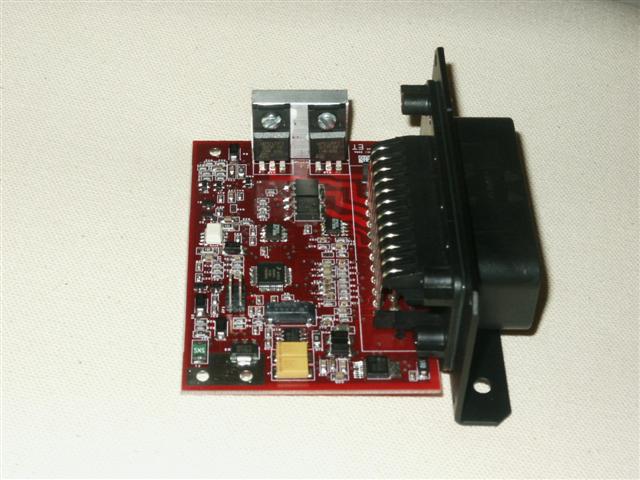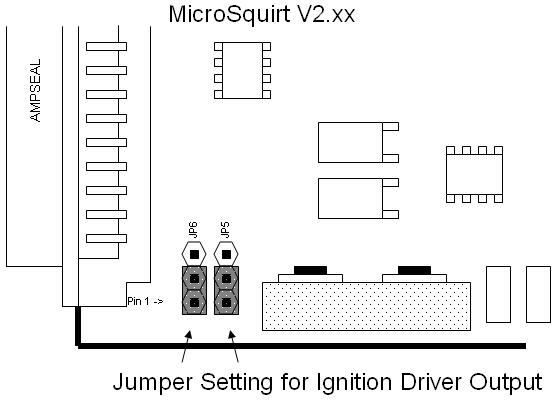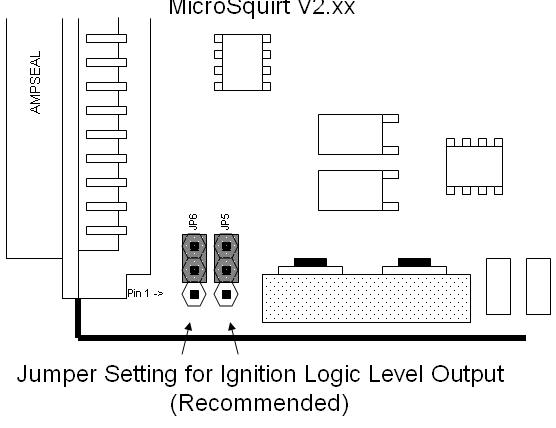
Click here for MegaSquirt® MegaManual™ Information, Guides, and Links

Many ignition modules (aka. "igniters") and some coils with built in igniters require a 'logic level' signal. Generally this means a 0 or 5 Volt signal that changes from one of these levels to the other at appropriate times.
To generate logic-level signals rather than control coils directly (which supplies either a 'ground' or 'high impedance'), you will need modify the MicroSquirt® to provide logic-level drive output. The changes you need top make depend is you have a:
V1 MicroSquirt® (red solder mask) users can do this by removing the VB921 and jumpering 2 of its holes on the PCB. It is easy to do, just solder in a short jumper (made from a bit of snipped off lead from a resistor, etc.) where the VB921's VIN and HVc terminals went into the PCB (see below).
Also, it is a good idea to add a 0.001 µF cap from this jumper to ground (the third terminal on the absent VB921 slot is ground) - see below. This capacitor shunts high frequency ( = radio frequency = RF) signals to ground so that they do not get back to the processor and disrupt its functioning.
The VB921's are the two relatively large TO-220 modules bolted upright to the aluminum heat sink:

The pins on the VB921 are (from left to right as pictured above):

With this modification, a user can drive the 4-coil Bosch 211 igniter or the LSx series of coils.
Early V1 MicroSquirt® users (with a red solder mask) with the VB921 already in place could also leave in the VB921 and instead use a 4.7K resistor from Vref to the IGN output - HVC - (with a second one for the other channel, if used) and invert the drive to the VB921 in the MegaTune settings. The default state is that the VB921 is energized all the time, pulling the output low, when the dwell period occurs the VB921 is not energized and the resistor pulls the output up to Vref (5 Volts).
On the V2 MicroSquirt® (with the black solder mask on the PCB, as opposed to the red solder mask on the V1 MicroSquirt®s), the VB921 was changed to the Bosch BIP-373 device for the ignition driver stage. The BIP-373 is much more rugged and will shutdown on over-temperature. The older VB921 would often fail on over-temp conditions.
With the V2 MicroSquirt®, setting the unit up for logic level output is easy. There are jumpers on the board that configure this output between driver and logic output mode. The default factory position is BIP-373 driver output mode, it is set this way to test the drivers before shipping. To change the output mode to highly-desirable logic-level, remove the screws from the case and slide the MicroSquirt PCB out of the case. Hold the PCB with the ampseal pointing to the left and the silver heatsink along the bottom. The jumpers are on the lower left of the board near the edge, right next to the ampseal connector and the silver heatsink. Connect the jumpers as the diagram below for logic-level output (first image is for the on-board drivers, the second is the preferred logic-level output mode):


There is a driver on the MicroSquirt®, the BIP373, which can drive an ignition coil directly. The BIP-373 is a real upgrade to the VB921 drivers that were used on the original MicroSquirt® V1 board. The biggest improvement is a thermal shutdown capability that will self-protect the driver in case of over-temperature. The older VB921 did not have this, and would simply self-destruct due to the heat from over-current limiting. Also, the BIP-373 has a higher flyback voltage (350V compared to 300V), and a current limit of around 12 amps (peak depends on ignition coil used and its resistance), compared to the 7 amps of the VB921. When the current limit is reached, the device will dump the excess voltage as heat in the driver, so the higher current limit headroom of the BIP-373 is good thing, and chances are the 12A limit will not be reached depending on dwell and ignition coil inductance.
The BIP-373 driver works well in the MicroSquirt®. However, it can be a bit of a challenge to get working on some installations. The reason is that the ignition driver circuit has to handle lots of current (up to 12 amps per channel, and there are two channels). Also, the flyback pulse on the ignition driver can reach 350 volts during discharge, and this can cause all sorts of pulse noise havoc to the rest of the system. This is one big reason why most OEM installations separate the ignition drivers (a.k.a. ignitors) from the ECM, it really improves signal integrity for the rest of the system. Finally, the BIP-373 can only handle one coil (do not attempt to hook up more than one coil per driver) and many installs want to drive two coils per channel to maintain a COP arrangement for a 4 cylinder.
With this in mind, we strongly recommend that your installation uses an external ignition driver setup, and that you configure the MicroSquirt® for logic-level output mode. What this means is that the MicroSquirt® will provide a 0-5 volt signal output of low current which is then used to trigger an external driver module. The MicroSquirt® documentation outlines several driver modules that can be used and how to hook them up. You can also use external BIP-373 drivers on your own board to drive the coils. The new ignition coils with the built-in ignitors (like the LS1/LS2 coils) work great and really make the installation robust and easy. Also, setups using EDIS, etc. will benefit from the logic-level mode as well.